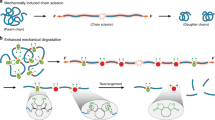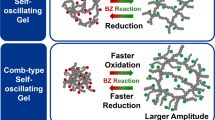Abstract
In polymer chemistry, mechanical energy degrades polymeric chains. In contrast, in nature, mechanical energy is often used to create new polymers. This mechanically stimulated growth is a key component of the robustness of biological materials. A synthetic system in which mechanical force initiates polymerization will provide similar robustness in polymeric materials. Here we show a polymerization of acrylate monomers initiated and controlled by mechanical energy provided by ultrasonic agitation. The activator for an atom-transfer radical polymerization is generated using piezochemical reduction of a Cu(II) precursor complex, which thus converts a mechanical activation of piezoelectric particles to the synthesis of a new material. This polymerization reaction has some characteristics of controlled radical polymerization, such as narrow molecular-weight distribution and linear dependence of the polymeric chain length on the time of mechanical activation. This new method of controlled radical polymerization complements the existing methods to synthesize commercially useful well-defined polymers.
This is a preview of subscription content, access via your institution
Access options
Subscribe to this journal
Receive 12 print issues and online access
$259.00 per year
only $21.58 per issue
Buy this article
- Purchase on Springer Link
- Instant access to full article PDF
Prices may be subject to local taxes which are calculated during checkout




Similar content being viewed by others
References
Chen, J.-H., Liu, C., You, L. & Simmons, C. A. Boning up on Wolff's Law: mechanical regulation of the cells that make and maintain bone. J. Biomech. 43, 108–118 (2010).
Christen, P. et al. Bone remodelling in humans is load-driven but not lazy. Nat. Commun. 5, 4855 (2014).
Li, J., Nagamani, C. & Moore, J. S. Polymer mechanochemistry: from destructive to productive. Acc. Chem. Res. 48, 2181–2190 (2015).
Brown, C. L. & Craig, S. L. Molecular engineering of mechanophore activity for stress-responsive polymeric materials. Chem. Sci. 6, 2158–2165 (2015).
Larsen, M. B. & Boydston, A. J. Investigations in fundamental and applied polymer mechanochemistry. Macromol. Chem. Phys. 217, 354–364 (2016).
Piermattei, A., Karthikeyan, S. & Sijbesma, R. P. Activating catalysts with mechanical force. Nat. Chem. 1, 133–137 (2009).
White, S. R. et al. Autonomic healing of polymer composites. Nature 409, 794–797 (2001).
Xia, Y. & Whitesides, G. M. Soft lithography. Angew. Chem. Int. Ed. 37, 550–575 (1998).
Diesendruck, C. E., Sottos, N. R., Moore, J. S. & White, S. R. Biomimetic self-healing. Angew. Chem. Int. Ed. 54, 10428–10447 (2015).
Dong, P. et al. Solid–liquid self-adaptive polymeric composite. ACS Appl. Mater. Interfaces 8, 2142–2147 (2016).
Leibfarth, F. A., Mattson, K. M., Fors, B. P., Collins, H. A. & Hawker, C. J. External regulation of controlled polymerizations. Angew. Chem. Int. Ed. 52, 199–210 (2013).
Ogawa, K., Goetz, A. & Boydston, A. Developments in externally regulated ring-opening metathesis polymerization. Synlett 27, 203–214 (2016).
Kean, Z. S. & Craig, S. L. Mechanochemical remodeling of synthetic polymers. Polymer 53, 1035–1048 (2012).
Caruso, M. M. et al. Mechanically-induced chemical changes in polymeric materials. Chem. Rev. 109, 5755–5798 (2009).
Matyjaszewski, K. & Spanswick, J. Controlled/living radical polymerization. Mater. Today 8, 26–33 (2005).
Matyjaszewski, K. & Xia, J. Atom transfer radical polymerization. Chem. Rev. 101, 2921–2990 (2001).
Jakubowski, W. & Matyjaszewski, K. Activator generated by electron transfer for atom transfer radical polymerization. Macromolecules 38, 4139–4146 (2005).
Tasdelen, M. A., Uygun, M. & Yagci, Y. Photoinduced controlled radical polymerization in methanol. Macromol. Chem. Phys. 211, 2271–2275 (2010).
Magenau, A. J. D., Strandwitz, N. C., Gennaro, A. & Matyjaszewski, K. Electrochemically mediated atom transfer radical polymerization. Science 332, 81–84 (2011).
Hong, K.-S., Xu, H., Konishi, H. & Li, X. Direct water splitting through vibrating piezoelectric microfibers in water. J. Phys. Chem. Lett. 1, 997–1002 (2010).
Wang, X., Song, J., Liu, J. & Wang, Z. L. Direct-current nanogenerator driven by ultrasonic waves. Science 316, 102–105 (2007).
Qin, Y., Wang, X. & Wang, Z. L. Microfibre–nanowire hybrid structure for energy scavenging. Nature 451, 809–813 (2008).
Wang, Z. L. & Song, J. Piezoelectric nanogenerators based on zinc oxide nanowire arrays. Science 312, 242–246 (2006).
Starr, M. B. & Wang, X. Coupling of piezoelectric effect with electrochemical processes. Nano Energy 14, 296–311 (2015).
Hong, K.-S., Xu, H., Konishi, H. & Li, X. Piezoelectrochemical effect: a new mechanism for azo dye decolorization in aqueous solution through vibrating piezoelectric microfibers. J. Phys. Chem. C 116, 13045–13051 (2012).
Qiu, J., Matyjaszewski, K., Thouin, L. & Amatore, C. Cyclic voltammetric studies of copper complexes catalyzing atom transfer radical polymerization. Macromol. Chem. Phys. 201, 1625–1631 (2000).
Krys, P., Ribelli, T. G., Matyjaszewski, K. & Gennaro, A. Relation between overall rate of ATRP and rates of activation of dormant species. Macromolecules 49, 2467–2476 (2016).
Haas, I. & Gedanken, A. Sonoelectrochemistry of Cu2+ in the presence of cetyltrimethylammonium bromide: obtaining CuBr instead of copper. Chem. Mater. 18, 1184–1189 (2006).
Chou, H. C. J. & Stoffer, J. O. Ultrasonically initiated free radical-catalyzed emulsion polymerization of methyl methacrylate (i). J. Appl. Poly. Sci. 72, 797–825 (1999).
Paulusse, J. M. J. & Sijbesma, R. P. Ultrasound in polymer chemistry: revival of an established technique. J. Polym. Sci. A 44, 5445–5453 (2006).
Alexander, P. & Fox, M. The role of free radicals in the degradation of high polymers by ultrasonics and by high-speed stirring. J. Polym. Sci. 12, 533–541 (1954).
Henglein, V. A. Die Bildung von Graftpolymeren aus Polyacrylamid und Acrylnitril unter dem Einfluß von Ultraschallwellen. Makromol. Chem. 14, 128–145 (1954).
Bartsch, A. & Schmidt-Naake, G. N-Oxyl-controlled radical copolymerization of styrene with ethyl α-cyanocinnamate. Macromol. Chem. Phys. 205, 1519–1524 (2004).
Ramirez, A. L. B. et al. Mechanochemical strengthening of a synthetic polymer in response to typically destructive shear forces. Nat. Chem. 5, 757–761 (2013).
Kryger, M. J. et al. Masked cyanoacrylates unveiled by mechanical force. J. Am. Chem. Soc. 132, 4558–4559 (2010).
Acknowledgements
SEM work was performed at the Laboratory for Electron and X-ray Instrumentation (LEXI) at UC Irvine, using instrumentation funded in part by the National Science Foundation Center for Chemistry at the Space-Time Limit (CHE-082913). A.P.E.K. acknowledges an AFOSR Young Investigator Grant under FA9550-12-1-0352, FA9550-15-1-0300 and FA9550-16-1-0017, a 3M Non-Tenured Faculty award and a DARPA Young Faculty Award for support. M.K. acknowledges the Israeli council for higher education for support.
Author information
Authors and Affiliations
Contributions
H.M., A.P.E.-K. and M.K. conceived and designed the experiments. H.M. and M.K. performed the experiments. M.K. performed the electron microscopy experiments. All the authors analysed the results and co-wrote the manuscript.
Corresponding author
Ethics declarations
Competing interests
The authors declare no competing financial interests.
Supplementary information
Supplementary information
Supplementary information (PDF 4978 kb)
Rights and permissions
About this article
Cite this article
Mohapatra, H., Kleiman, M. & Esser-Kahn, A. Mechanically controlled radical polymerization initiated by ultrasound. Nature Chem 9, 135–139 (2017). https://doi.org/10.1038/nchem.2633
Received:
Accepted:
Published:
Issue Date:
DOI: https://doi.org/10.1038/nchem.2633
This article is cited by
-
A contact-electro-catalysis process for producing reactive oxygen species by ball milling of triboelectric materials
Nature Communications (2024)
-
Bioinspired nanocomposites with self-adaptive mechanical properties
Nano Research (2024)
-
Covalent organic frameworks
Nature Reviews Methods Primers (2023)
-
Polymer-modified regenerated cellulose membranes: following the atom transfer radical polymerization concepts consistent with the principles of green chemistry
Cellulose (2023)
-
Synergically enhanced piezocatalysis performance of eco-friendly (K0.52Na0.48)NbO3 through ferroelectric polarization and defects
International Journal of Minerals, Metallurgy and Materials (2023)



